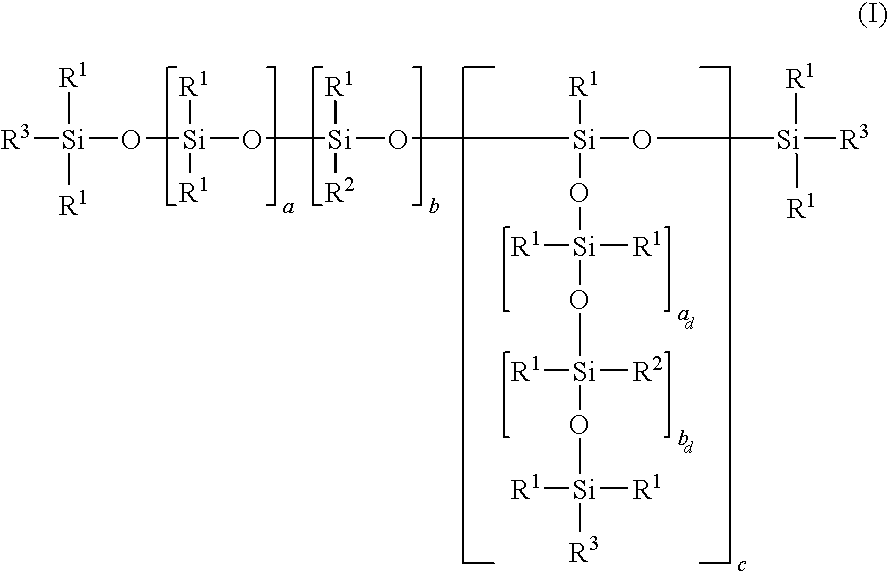Silicone (METH)acrylate particles, process for preparation thereof and use thereof
a technology of organic polysiloxane and acrylate, which is applied in the field of preparation of organic polysiloxane (meth) acrylate particles, can solve the problems of inability to achieve the skinfeel and personal care application desired by personal care applications, reaction products of free-radical initiators remain in the polymer, and achieve good free flow
- Summary
- Abstract
- Description
- Claims
- Application Information
AI Technical Summary
Benefits of technology
Problems solved by technology
Method used
Image
Examples
example 1
Particles of TEGO® RC 726 Silicone Acrylate
[0096]7600 g of demineralized water and 276 g of Ludox SM-AS were mixed and adjusted to pH 7 with hydrochloric acid. The mixture was initially charged in a stirred tank of a Co-Twister homogenizer (Symex), and 2156 g of TEGO® RC 726 (Evonik Goldschmidt GmbH) were added with stirring. After the tank had been closed, with gentle stirring, the tank was evacuated to 50 mbar and, after the evolution of foam had abated, vented back to 800 mbar. The mixture was subsequently pre-emulsified at a rotor speed of 2000 rpm and a differential speed of 20 m / s for 15 min in the system cycle. After 64.3 g of a 5% by weight aqueous CTAB (cetyltrimethylammonium bromide) solution and then 420 g of demineralized water had been sucked in, the mixture was emulsified under the same conditions for an additional 45 minutes. The resulting preliminary emulsion was homogenized by passing through a homogenizer (in the examples, a Microfluidizer from Microfluidics was us...
example 2
Particles of TEGO® RC 902 Silicon Acrylate
[0098]4650 g of demineralized water and 160 g of Ludox SM-AS were mixed and adjusted to pH 7 with hydrochloric acid. The mixture was initially charged in a stirred tank of a Co-Twister homogenizer (Symex), and 1250 g of TEGO® RC 902 (Evonik Goldschmidt GmbH) were added with stirring. After the tank had been closed, with gentle stirring, the tank was evacuated to 50 mbar and, after the evolution of foam had abated, vented back to 800 mbar. The mixture was subsequently pre-emulsified at a rotor speed of 2000 rpm and a differential speed of 20 m / s for 15 min in the system cycle. After 37.3 g of a 5% by weight aqueous CTAB (cetyltrimethylammonium bromide) solution and then 245 g of demineralized water had been sucked in, the mixture was emulsified under the same conditions for an additional 45 minutes. The resulting preliminary emulsion was homogenized by passing through a homogenizer with an interaction chamber of diameter 200 μm at pressure 80...
example 3
Particles of TEGO® RC 2015 Silicone Acrylate
[0100]4000 g of demineralized water and 800 g of Ludox SM-AS were mixed and adjusted to pH 7 with hydrochloric acid. The mixture was initially charged together with 18 600 g of demineralized water in a stirred tank of a Co-Twister homogenizer (Symex), and 6250 g of TEGO® RC 2015 (Evonik Goldschmidt GmbH) were added with stirring. After the tank had been closed, with gentle stirring, the tank was evacuated to 50 mbar and, after the evolution of foam had abated, vented back to 600 mbar. The mixture was subsequently pre-emulsified at a rotor speed of 3500 rpm and a differential speed of 40 m / s for 45 min. After 157.5 g of a 5% by weight aqueous CTAB (cetyltrimethylammonium bromide) solution and then 400 g of demineralized water had been sucked in, the mixture was emulsified under the same conditions for an additional 45 minutes. Before the mixture was discharged, it was deaerated at 200 mbar and a rotor speed of 2000 rpm with co-rotatory roto...
PUM
| Property | Measurement | Unit |
|---|---|---|
| pressure | aaaaa | aaaaa |
| capillary thickness | aaaaa | aaaaa |
| size | aaaaa | aaaaa |
Abstract
Description
Claims
Application Information
 Login to View More
Login to View More - R&D
- Intellectual Property
- Life Sciences
- Materials
- Tech Scout
- Unparalleled Data Quality
- Higher Quality Content
- 60% Fewer Hallucinations
Browse by: Latest US Patents, China's latest patents, Technical Efficacy Thesaurus, Application Domain, Technology Topic, Popular Technical Reports.
© 2025 PatSnap. All rights reserved.Legal|Privacy policy|Modern Slavery Act Transparency Statement|Sitemap|About US| Contact US: help@patsnap.com



